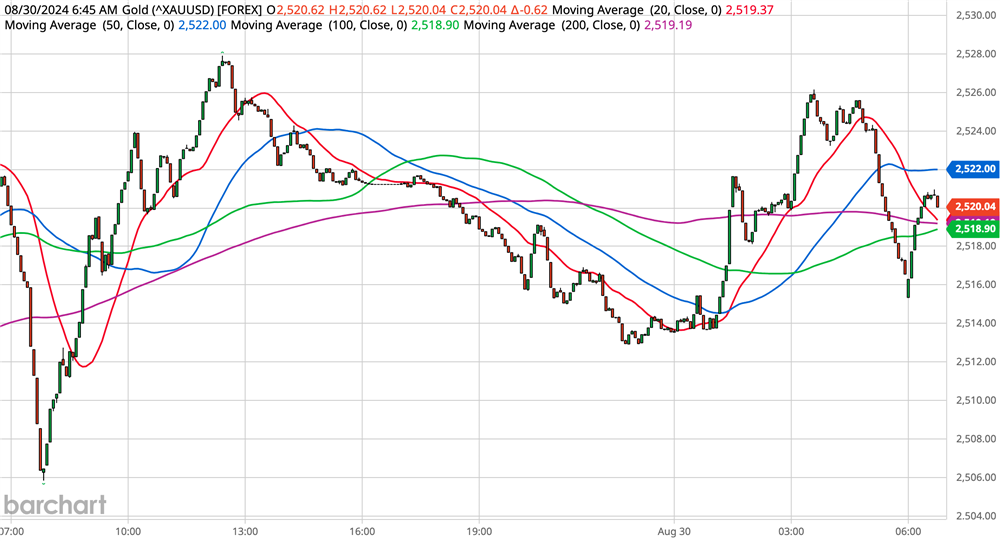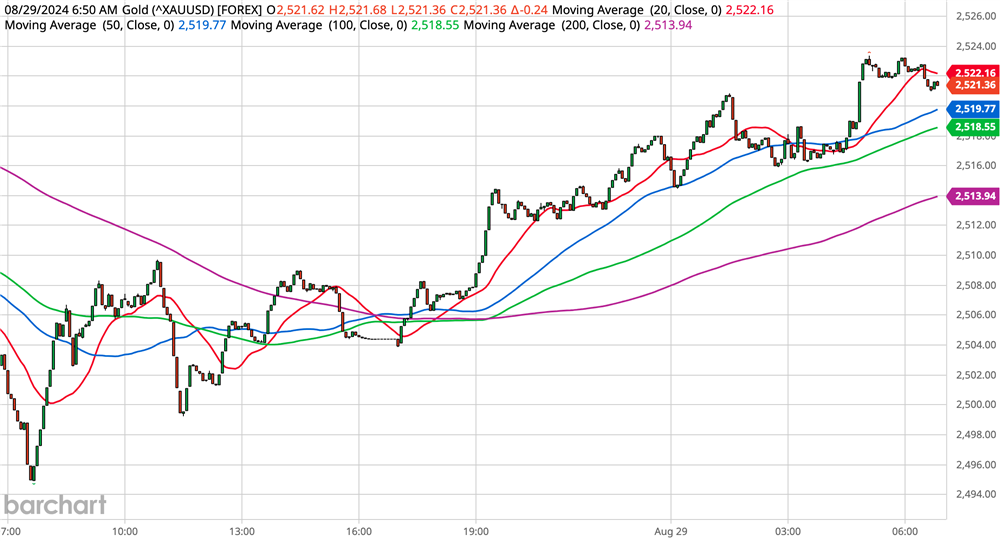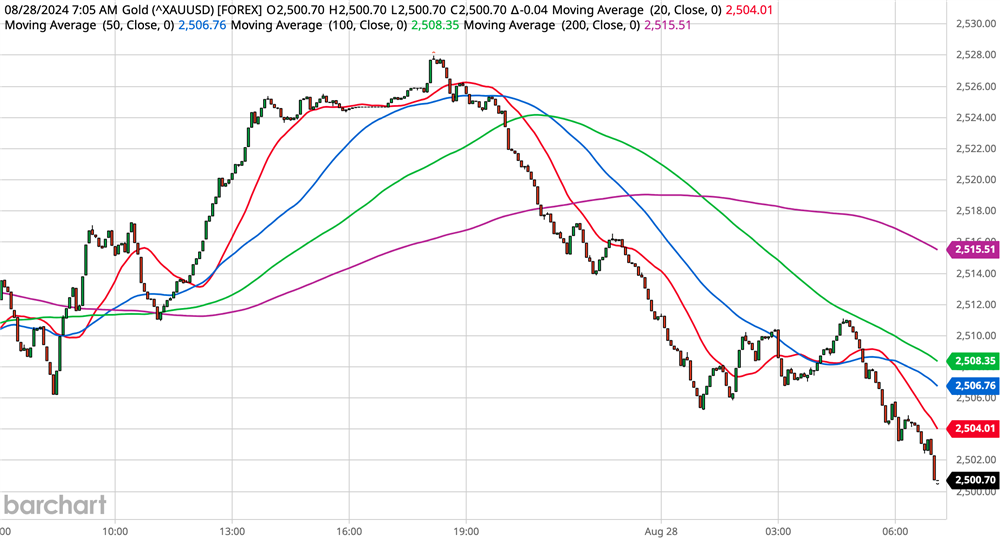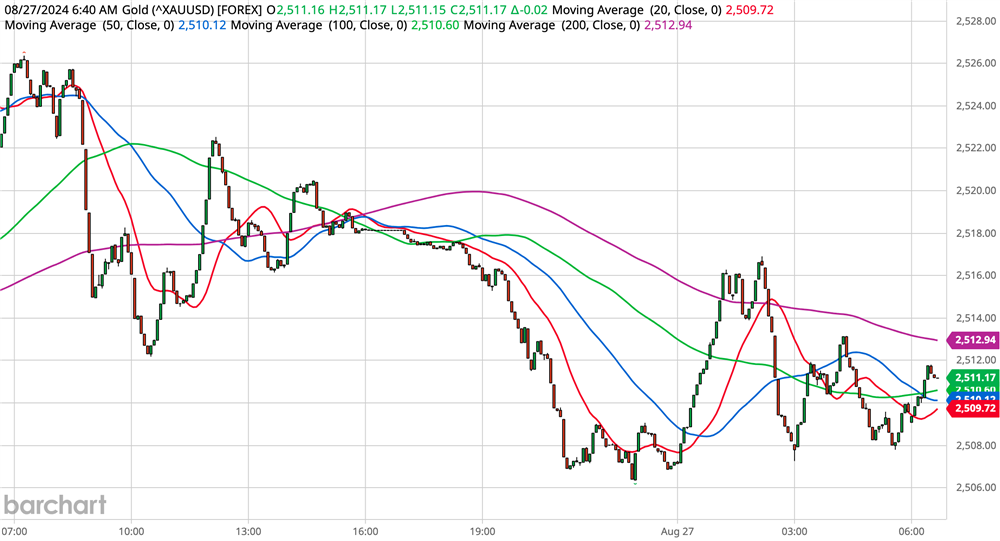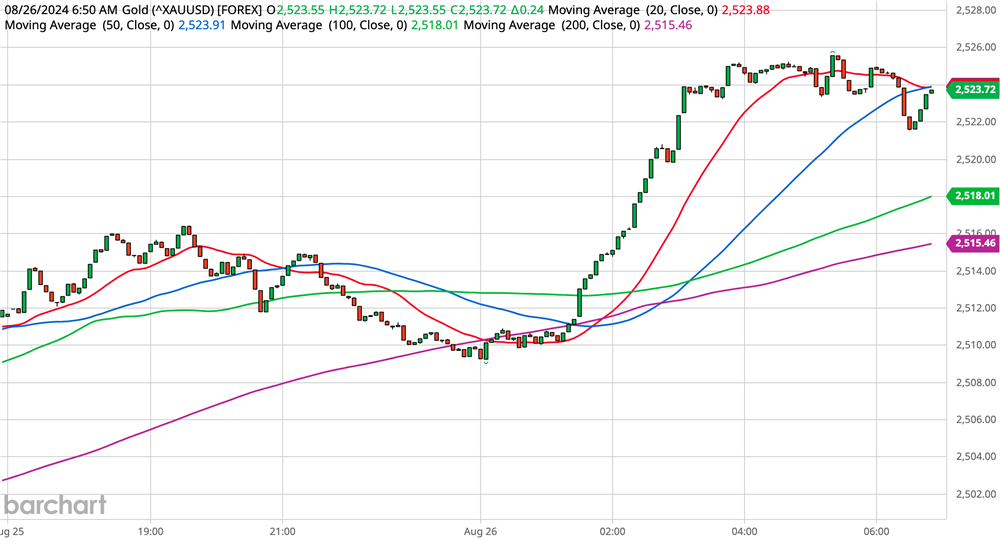Zaner Daily Precious Metals Commentary
Friday, August 30, 20248/30/2024
Gold and silver slide ahead of the holiday weekend on pared rate cut bets and a stronger dollar
OUTSIDE MARKET DEVELOPMENTS: The table remains set for a Fed rate cut in September following this morning's economic data. It would be the first rate cut in more than four years.
Chicago PMI rose to 46.1 in August, above expectations of 44.5, versus 45.3 in July. Boeing issues remain a headwind, keeping the indicator in contraction territory.
The final Michigan Sentiment reading for August edged up to 67.9, from the preliminary print of 67.8. Sentiment remains well off the high for the year set in March at 79.4.
One-year inflation expectations were adjusted to a 44-month low of 2.8%, versus a preliminary print of 2.9%. The Buying Conditions for Houses index reached an all-time low of 23.

U.S. PCE rose 0.5% in July, above expectations of +0.4%, versus +0.3% in June. Personal income climbed 0.3% on expectations of +0.2%, versus +0.2% in June.
The chain price index – the Fed's preferred inflation indicator – rose 0.2% in July, in line with expectations. The annualized rate held steady at 2.5%. Core inflation also rose 0.2% m/m. The annualized rate was unchanged at 2.6% y/y on expectations of 2.7%.
I'd call the inflation readings benign, with year-over-year readings less than half of the post-COVID highs, but still above target. This lends further credence to the belief that the Fed's focus has shifted from price risks to growth risks.
The probability for a 50 bps rate cut edged lower, providing some support for the dollar. The dollar index set a new high for the week at 101.65.
There was some troubling news in this morning's data: The savings rate dropped to 2.9%, versus a negatively revised 3.1% in June. That leaves the savings rate just above the 14-year low of 2.7% from June 2022.
Dollar General shares plunged this week after the company slashed earnings and profit guidance. CEO Todd Vasos said their core customers are "less confident of their financial position" and are having to make hard choices at the discount retailer.
"Inflation has continued to negatively impact these households with more than 60% claiming they have had to sacrifice on purchasing basic necessities due to the higher cost of those items, in addition to paying more for expenses such as rent, utilities and healthcare," said Vasos. Those who earn the least are the most impacted by inflation, particularly when it comes to necessities such as food, fuel, and shelter.
"More of our customers report that they are now resorting to using credit cards for basic household needs and approximately 30% have at least one credit card that has reached its limit," added Vasos.
Credit card balances increased by $27 billion in Q2 to reach a record high $1.14 trillion according to a recent report by the New York Fed. Contrasting rising credit card debt with the declining savings rate paints a pretty grim picture.

With the average credit card interest rate at 27.64%, according to Forbes Advisor’s weekly credit card rates report, this is a hole that many simply won't be able to claw their way out of. Not surprisingly, the delinquency rate reached a more than 12-year high of 3.25% in Q2.
Looking at total household debt, the picture is even more disturbing. Total household debt rose by $109 billion to reach a record $17.80 trillion in Q2.

This week's upward revision in Q2 GDP to 3.0% was driven largely by stronger-than-expected consumer spending. Consumption was revised up to 2.9% from 2.3% in the first report.
However, that strong consumption is being fueled largely by debt. That's simply unsustainable.
While the Fed is rightly shifting its attention to growth risks, policymakers must be careful not to restoke inflation in the process. I think they will be cautious with the first cut in September unless there is a significant downside surprise in August jobs data, which comes out next Friday.
GOLD
OVERNIGHT CHANGE THROUGH 6:00 AM CDT: -$6.07 (-0.24%)
5-Day Change: -$14.27 (-0.57%)
YTD Range: $1,986.16 - $2,529.57
52-Week Range: $1,812.39 - $2,529.57
Weighted Alpha: +30.32
Gold went back on the defensive in early U.S. trading, weighed by diminished expectations for a 50 bps rate cut and a stronger dollar. While the yellow metal appears poised for a lower weekly close, it will notch a seventh consecutive higher monthly close.
At this point, the low for the week set on Wednesday at $2,494.93 remains intact. This keeps more important support at $2,474.31/16 (22-Aug low, and 20-day SMA) at bay.
A rebound back above $2500 early next week would bode well for another run at $2,527.97/$2,529.57. Penetration of the latter would establish new record highs and boost confidence in my previously established upside objectives at $2,539.77 (Fibonacci) and $2,597.15/$2,600.00 (measuring objective).
Thin holiday trading is likely to be seen on Monday with U.S. markets closed in observance of Labor Day. Our Tornado precious metals hedging platform will close early at 12:30 CDT on Monday, September 2.
A study by Wisdom Tree found that a gold allocation of 16–19% in a portfolio maximizes risk-adjusted returns. A special report by Incrementum was released today that identifies the ideal allocation to gold as 14–18%.
"A 40% gold allocation might offer the highest returns, but it also comes with significantly higher volatility and drawdowns." according to the report.
In a post on X today, Incrementum notes that gold's total estimated market capitalization is approaching %18 trillion.

Perhaps surprisingly, many investors have little or no allocation to gold at all. Do you have enough gold?
SILVER
OVERNIGHT CHANGE THROUGH 6:00 AM CDT: -$0.010 (-0.03%)
5-Day Change: -$1.082 (-3.63%)
YTD Range: $21.945 - $32.379
52-Week Range: $20.704 - $32.379
Weighted Alpha: +20.43
Silver tumbled to a new low for the week in U.S. trading on Friday. The white metal is poised to notch its first lower weekly close in three (outside week), and a third consecutive lower monthly close (confirmed on a close below $28.998).
Perhaps there's a growing realization that while consumer electronics, solar panels, and EVs all require significant loads of silver, at least American consumers are losing confidence and are already saddled with a massive amount of debt. Who's going to buy these silver-laden products?
The violations of supports at $29.176/159 (50- and 100-day SMAs) and $28.830 (22-Aug low) leave the 20-day moving average at $28.556 vulnerable to a test. Secondary support is noted at $28.078/$28.000.
A climb back above the 50- and 100-day moving averages would take the short-term pressure off the downside, but silver continues to disappoint. The failure to sustain gains above $30 this week leaves the highs for the year above $32 well protected for the time being.
Peter A. Grant
Vice President, Senior Metals Strategist
Zaner Metals LLC
Tornado Precious Metals Solutions by Zaner
312-549-9986 Direct/Text
[email protected]
www.ZanerPreciousMetals.com
www.TornadoBullion.com
X: @GrantOnGold
X: @ZanerMetals
Facebook: @ZanerPreciousMetals
Non-Reliance and Risk Disclosure: The opinions expressed here are for general information purposes only and should not be construed as trade recommendations, nor a solicitation of an offer to buy or sell any precious metals product. The material presented is based on information that we consider reliable, but we do not represent that it is accurate, complete, and/or up-to-date, and it should not be relied on as such. Opinions expressed are current as of the time of posting and only represent the views of the author and not those of Zaner Metals LLC unless otherwise expressly noted.
